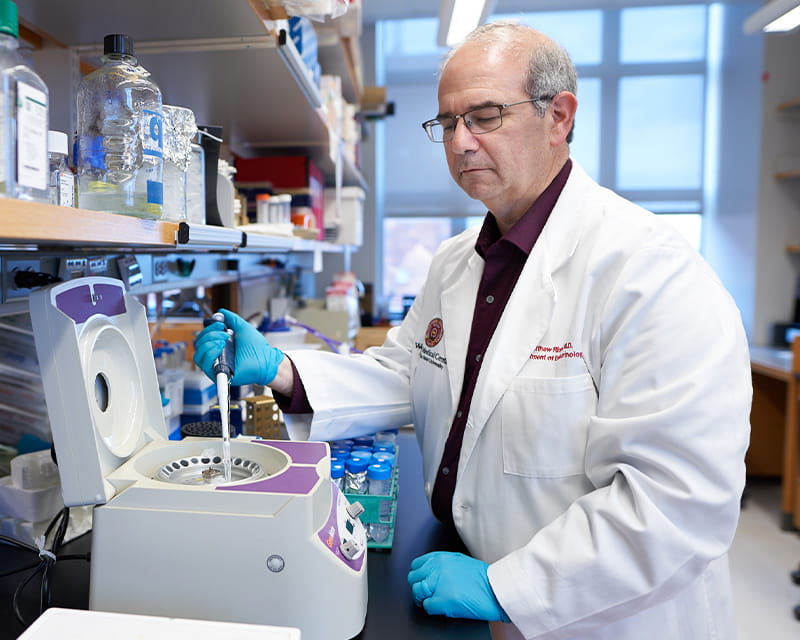
Studying “brake failure” in thyroid cancer metastasis
 Patients with thyroid nodules and cancer routinely travel from around Ohio and even around the world for treatment from The Ohio State University Wexner Medical Center’s and The Ohio State University Comprehensive Cancer Center – Arthur G. James Cancer Hospital and Richard J. Solove Research Institute highly recognized interdisciplinary team. “Our clinicians understand the importance of clear communication and shared terminology when discussing cases between medical centers, with providers from different specialties, and with patients,” says Jennifer Sipos, MD, an Ohio State endocrinologist.
Patients with thyroid nodules and cancer routinely travel from around Ohio and even around the world for treatment from The Ohio State University Wexner Medical Center’s and The Ohio State University Comprehensive Cancer Center – Arthur G. James Cancer Hospital and Richard J. Solove Research Institute highly recognized interdisciplinary team. “Our clinicians understand the importance of clear communication and shared terminology when discussing cases between medical centers, with providers from different specialties, and with patients,” says Jennifer Sipos, MD, an Ohio State endocrinologist.
“Unfortunately, collaboration between physicians in different countries or regions can be difficult when they don’t share the same terminology or consistent diagnostic language.”
As a member of the International Thyroid Nodule Ultrasound Working Group, Dr. Sipos is working with endocrinologists, radiologists and surgeons from around the world to develop a universal lexicon so that physicians can begin using the same terminology to describe thyroid nodules.
“Standardizing our verbiage will improve collaboration and research in so many ways,” Dr. Sipos says. “Our team has been categorizing the different terms used across the world, and the new lexicon — which will be called I-TIRADS for International Thyroid Imaging, Reporting and Data Systems — includes standardized verbiage, some new words and final definitions. It should be released in 2023, and it will make it so much easier to review research, discuss cases and compare outcomes going forward.”
In other leadership roles, Dr. Sipos is one of 24 medical experts on the National Comprehensive Cancer Network (NCCN) Thyroid Carcinoma Panel, which reviews and updates that organization’s treatment recommendations each year, and she serves on the work group updating the American Association of Endocrine Surgeons’ Thyroidectomy Guidelines. She is also one of just 12 committee members tasked with updating the American Thyroid Association (ATA) Nodule Guidelines, which are used across the world and considered a gold standard for best practices.
“We’ve been revamping the ATA guidelines for over three years,” she says. “These updates will be more inclusive and support more flexible management. It’s been an honor to be part of the process.”
In the area of thyroid cancer, Matthew Ringel, MD, is co-chair of the ATA Differentiated Thyroid Cancer Guidelines Task Force. In this role, he leads the association’s assessment and update of current clinical management guidelines and new treatment options to provide clinicians a science-based review of treatment benefits or limitations using a patient-centered approach. The task force also includes Ohio State genetic counselor Pamela Brock, MS, LGC.
“The pace of change in medicine only seems to accelerate,” Dr. Ringel says. “That makes these updated guidelines crucial, because they’re developed with consideration of so many resources —research and literature that no single physician would have time to review on their own.
“While there remains no one-size-fits-all solution for patients with thyroid cancer, these ATA guidelines will continue to provide an important framework for more effective care that reflects the most recent research and clinical data in the field.”
In addition to this ATA co-chair position, Dr. Ringel previously served on the NCCN Thyroid Carcinoma Panel and the ATA Medullary Thyroid Cancer Guidelines Task Force. He is also a co-author of the American Head and Neck Society Endocrine Surgery Section and International Thyroid Oncology Group consensus statement on mutational testing in thyroid cancer: Defining advanced thyroid cancer and its targeted treatment.
Each of the roles held by Dr. Ringel, Dr. Sipos and Brock build on a tradition of leadership established by other Ohio State team members in endocrinology, medical oncology and surgical oncology who’ve served on or led ATA and NCCN thyroid cancer panels over the last 20 years.
“Our team’s ongoing participation with these national and international groups has not only enhanced our own clinical practice, but has also improved care of patients more broadly,” Dr. Ringel says. “We’ve been fortunate to have the incredible opportunity to work together with other experts, patients and professional societies to help bring optimal care to patients with thyroid nodules and cancer. The transformation of management from a one-size-fits-all approach to one that is more individualized and patient-centered has been remarkable.”
“The kind of collaboration we’ve learned while serving on these different committees has also strengthened our own multidisciplinary teamwork here at Ohio State, where endocrinologists remain a central member of the care team to ensure continuity from initial diagnosis through follow-up, even for patients with thyroid cancer,” says Dr. Sipos, who works in the Thyroid Cancer Unit at The Ohio State University Comprehensive Cancer Center – Arthur G. James Cancer Hospital and Richard J. Solove Research Institute (OSUCCC – The James).
Patients from across the nation travel to Ohio State for thyroid nodule and cancer treatment and to participate in clinical trials and studies of cancer genetics. We offer fine needle aspiration, thyroid cancer surgery and radioiodine therapy, as well as innovations that include radiofrequency ablation, ethanol ablation or targeted therapies for patients who have thyroid cancers that don’t respond to radioiodine therapy.
Both radiofrequency and ethanol ablation are examples of innovative nonsurgical options now available at Ohio State for patients with toxic or hot nodules. “These advancements have been particularly attractive to patients at high surgical risk who don’t want to undergo surgery but still require treatment,” Dr. Sipos says. “As for ethanol ablation, we’ve used it on cystic and small metastatic nodules, and it allows us to remove fluid and shrink the tumor without surgery.”
“Of course, with a significant number of patients having thyroid cancers that no longer take up or respond to radioiodine therapy, one of the most exciting treatment advancements we offer are targeted therapies based on the identification of specific genomic changes on molecular tumor testing of the tumor tissue,” Dr. Ringel says.
“If an oncogene is identified for which there is a specific targeted therapy, those medications can be used as primary therapy, oftentimes with fewer side effects than less specific drugs. Depending on the oncogene, these specific inhibitors can ‘redifferentiate’ the thyroid cancer, which enables a marked increase in radioiodine uptake. This property has been used to facilitate radioiodine therapy for patients with tumors that had stopped responding to this therapy, and when we do move to the iodine phase, we use dosimetry to make sure we’re delivering enough to be effective, but not too much to trigger side effects,” he says.
Ohio State has been offering redifferentiation therapy for several years, and Dr. Sipos notes its ability to slow tumor progression. “We’ve seen stabilization and actual regression in some patients,” she says.
For patients or physicians interested in learning more about thyroid nodule and cancer treatment at Ohio State, contact the Division of Endocrinology, Diabetes and Metabolism at 614-293-4326 or fax a referral form to 614-293-1456.
For cancer treatment at the OSUCCC – James, call 800-293-5066 or fax a referral form to 614-293-9449.